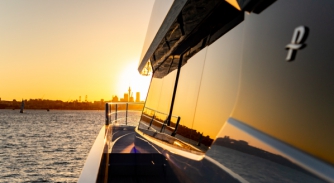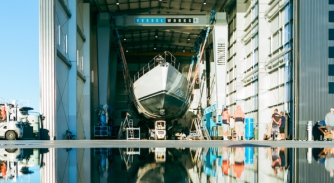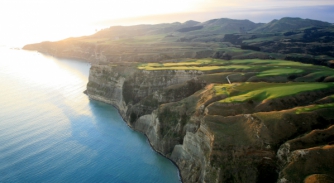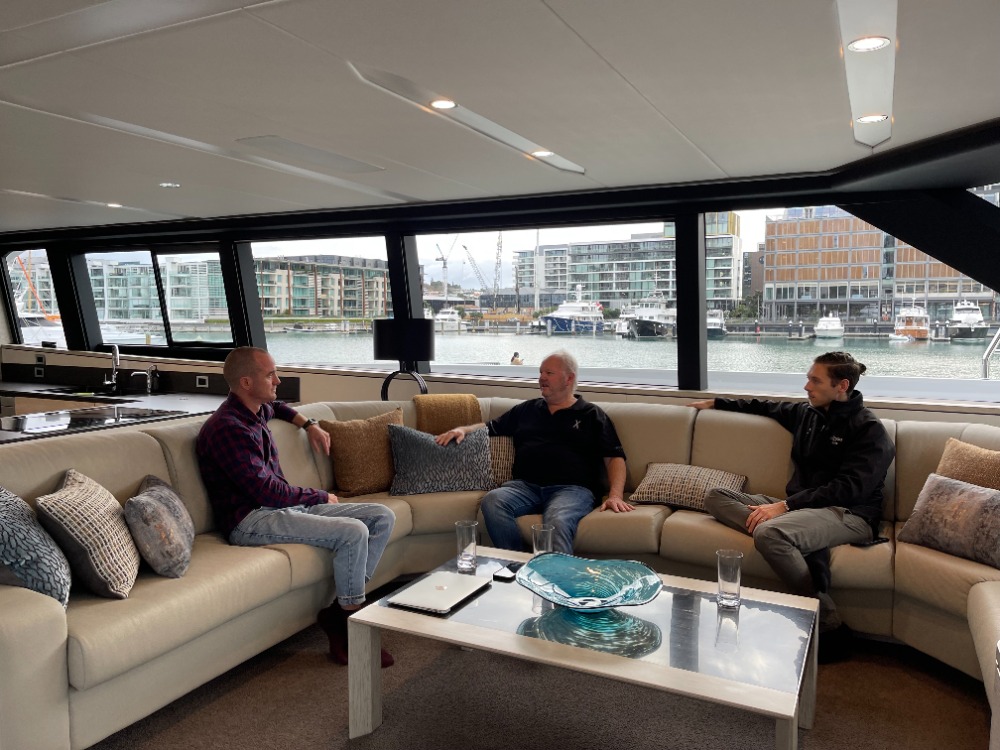Pachoud Yachts and the foil assist
New Zealand superyacht building father and Son, Dave and Mitch Pachoud, discuss the philosophy behind the efficiency of their designs…
Multihull superyachts are becoming a more common sight. High profile support yachts like Hodor, the 67m Catermaran built at Astilleros Armón, as a support vessel to Lonian, is one such eye-catching addition to the fleet. The benefits of multihulls are many and varied. Their hydrodynamics and efficiency lead to lower fuel consumption, and the onboard usable space is immense when compared to the LOA. One of the true pioneers of luxury multihulls is Dave Pachoud, from Pachoud Yachts and Voodoo Yachts. I caught up with Dave, and his son and business partner Mitch Pachoud, onboard their 2020 launch, the 27m Rua Moana.
Starting out building multihulls for his family to use over 30 years ago, Dave Pachoud and the team at Pachoud Yachts have quietly innovated the sector in South Pacific. One of the foundational innovations that they have pioneered is the use of a foil assist to increase the efficiency and high-speed range of their multihulls. As the fleet strives for a more sustainable future, fuel efficiency is a vital factor. The simple metric of less fuel burnt = less carbon released is simplistic, but nonetheless important. An imminently scalable system, their approach shows that there is plenty of room for innovation in hull design.
“The good thing about the foiling catamarans that we have developed,” explains Mitch Pachoud, “is that we have a platform that affords us the ability to look at the system at a fundamental level. We challenged how it operates; how much power is really required to move this boat? That then flows onto the environmental benefits."
One of the guiding principles for their custom and semi-custom multihulls is giving owners and operators the freedom to navigate the South Pacific. One of these owners is Craig Armstrong, of Rua Moana, who has owned four of Pachoud’s catamarans. He recounted to me that on one of the foil assisted models, they completed the crossing from Opua, in the Bay of Islands at the top of the North Island of New Zealand, to New Caledonia in just 27 hours. This journey of 900 nautical miles was made possible with relatively little fuel, because of the efficiency of the foil assist system.
 Voodoo Yachts expedition series, showing the foil assist ride height relative to the foil position midships
Voodoo Yachts expedition series, showing the foil assist ride height relative to the foil position midships
“We are not fully flying like the Team New Zealand folks are, we are foil assisted,” explains Dave Pachoud, “we first developed the system 10 years ago, and have refined it with each boat since then. We created it to be a practical South Pacific cruiser. An owner or captain can move quickly from New Zealand to Australia or Fiji at high speed, and efficiently. That is what drove the 1300 mile range. To achieve this we need it to be a very stable platform with simple drive lines with immersed propellers. When you start moving at over 40kts with immersed propellers, you have got to look at every part of your driveline, refining the struts and rudders. Everything needs to be perfectly streamlined.” Says Pachoud.
The foil assist involves integrated foils at midships that lift the majority of the hulls out of the water, similar to a planning vessel, but with significantly less fuel consumption and more stability. The decreased drag then allows much higher speeds relative to power output. Foiling boats are, of course, nothing new. Commercial applications are many and varied, but the private yacht sector has been relatively slow to adopt. As Dave Pachoud explains, the system fundamentally changes the way a passage is approached. “A lot of foils have been added to the boat after the fact, we wanted to design a hull that will have comfortable ride characteristics and efficiency while taking the load on the foils."
"We have really turned the whole passage making in the South Pacific on its head. The equation of carrying excessive amounts of fuel, and steaming at 8 knots to make the journey is not the only way to do it.” Says Dave Pachoud.
“What this creates is a different lifestyle,” adds Mitch Pachoud, “we want owners to be comfortable and interested in taking on these passages by themselves, or remaining on board with the crew. With the advancements in weather forecasting, picking a two or three-day weather window can be done with a high level of accuracy. Combined with the ability to travel at high speed over long distances this makes the passages achievable in good comfortable weather for the entire journey.”
Hi-performance foils are synonymous with hi-quality composite work. Carbon fibre specifically underpins the performance. Early adopters of the technology, Dave Pachoud reflects on the New Zealand pioneers that trailblazed its use in the marine sector. “A lot of the composite innovation in New Zealand started way back with guys like High Modulus (Hi-Mod). I brought my first material from Hi-Mod back in 1987 and engineered it into one of my first race boats. Guys like Richard Honey and Brian Jones trained a lot of people and really led the industry through those early innovations. Just look at KZ7 and early America’s Cup yachts. They left a legacy that is still strong in the New Zealand marine industry.”
The green credential of burning less fuel needs little explanation, but with alternative propulsion and energy generation the next big step for the industry, we discuss the implications for foil assisted systems. “We have looked at electrification,” concludes Dave Pachoud, “but to date, the equation has not stacked up. The better metric is hydrogen, which is going to be the game-changer. But the simple fact is, battery-electric has just never come down of the right side of the equation.”
How then would hydrogen fit into this equation? The energy density issues have affected many hopeful superyacht designs, and may yet hamper its widespread adoption. Often hydrogen systems are added to conventional hull designs with their inbuilt efficiencies, and this is where Pachoud Yachts may hold an advantage. “We would not redesign the whole boat for hydrogen,” says Mitch Pachoud, “we just need to look at how much range we could get from the hydrogen storage. It does not matter so much ultimately what propulsion system and fuel we put on top of it, the fact is that we have a highly efficient starting point that will get the most out of it.”
Fast and efficient 1300 mile crossings have obvious Mediterranean applications. And, as Mitch Pachoud explains, that range can be increased. The cross-crossing rooster's tails from overpowered yachts burning 100s of litres of fuel an hour at 30 knots may have been a badge of honour a generation ago, but will not be looked on kindly in hindsight. Foil assisted yachts like those pioneered for the South Pacific by Pachoud Yachts could be part of a more efficient and ultimately greener future for the fleet worldwide.
"This technology is highly scalable for larger yachts, and we would love to take on larger projects," concludes Mitch Pachoud. With the progression from a passion project for his family, to fully custom superyachts, the team at Pachoud Yachts have refined their innovations and is ready for the next big challenge. For an industry grappling with how to reconceive its footprint and the way it operates, the Kiwis, once again seem to have been quietly innovating and showing a way forward.
Main image and slider - Jack Hogan left, Dave Pachoud middle, Mitch Pachoud right
NEW: Sign up for SuperyachtNewsweek!
Get the latest weekly news, in-depth reports, intelligence, and strategic insights, delivered directly from The Superyacht Group's editors and market analysts.
Stay at the forefront of the superyacht industry with SuperyachtNewsweek
Click here to become part of The Superyacht Group community, and join us in our mission to make this industry accessible to all, and prosperous for the long-term. We are offering access to the superyacht industry’s most comprehensive and longstanding archive of business-critical information, as well as a comprehensive, real-time superyacht fleet database, for just £10 per month, because we are One Industry with One Mission. Sign up here.
Related news

Where two seas meet
Craig Armstrong, co-owner of Rua Moana, shares the story of building and chartering a uniquely New Zealand superyacht
Owner

S/Y Miss Silver completes 10 month refit in New Zealand
The 36m sloop from Alloy Yachts and Dubois marks 25 years of operation with a return to the water in Tauranga
Fleet

New Zealand’s sea and air borders are opening
The long-awaited announcement from the New Zealand government is welcome news for the local marine sector
Crew

Leading the Chase
Out on the water with Emirates Team New Zealand, and their game-changing foiling hydrogen chase boat
Technology
.jpeg)
Related news
Where two seas meet
4 years ago
New Zealand’s sea and air borders are opening
4 years ago
Leading the Chase
4 years ago
Orams Marine yard tour
4 years ago
NEW: Sign up for
SuperyachtNewsweek!
Get the latest weekly news, in-depth reports, intelligence, and strategic insights, delivered directly from The Superyacht Group's editors and market analysts.
Stay at the forefront of the superyacht industry with SuperyachtNewsweek




